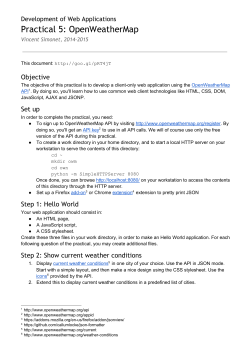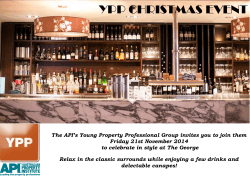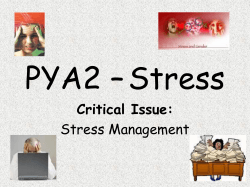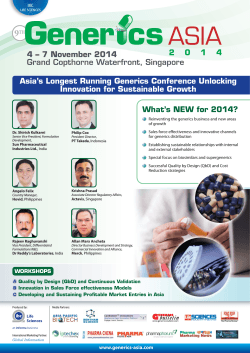
Tools and Strategies for Launching a Successful KATE KUHRT BERLIN
Tools and Strategies for Launching a Successful Generic in Today’s Ultra Competitive Environment KATE KUHRT BERLIN SEPTEMBER 27, 2008 BEST OF TIMES… • Population all over the world getting older • Increase in the size of middle class in many countries • Governments and employers promoting use of generic drugs in efforts to slow down increase in health care spending • Increased acceptance of generic drugs by patients and physicians • A number of blockbusters losing patent protection …AND WORST OF TIMES • Innovation drought • ANDA backlog and authorized generics • Pressure on prices and diminishing margins – Government regulation – Consolidation among wholesalers and retailers – Increased competition • Generic filings and approvals at all-time high • A number of new entrants, many from India, often with access to low-cost APIs • Overcapacity in manufacturing • Focus on market share rather than bottom line • Authorized generics in the U.S. ANDA APPROVALS BY INDIAN GENERICS 120 18 16 100 14 12 10 60 8 40 # Holders # ANDAs 80 Tentative Final Holders 6 4 20 2 0 0 1997 1998 1999 2000 2001 2002 2003 2004 2005 2006 2007* *Through August 15, 2007 Source: Newport Strategies’ Horizon Global system 2007 YTD FINAL ANDA APPROVALS BY COUNTRY Other; 20; 7% Iceland; 6; 2% Canada; 11; 4% Switzerland; 13; 4% USA; 116; 39% Israel; 23; 8% Germany; 25; 8% *Through August 15, 2007 Source: Newport Strategies’ Horizon Global system India; 85; 28% ARE THE GENERICS INDUSTRT’S GOLDEN YEARS OVER? • Expectation that only the fittest will survive • Coping strategies aimed at: – Reducing cost – Reducing risk – Improving speed to market – Differentiation – Achieving critical mass COPING STRATEGIES: CONSOLIDATION • Consolidation expected to continue in pursuit of – Top-line growth – Opportunities in new markets – Synergies • Example: Barr’s acquisition of Pliva – Biogenerics – New dose forms – Presence in emerging markets – Access to API • Result: Industry will likely be dominated by a handful of global players plus many small, focused players LEAGUE TABLES ARE CONSTANTLY SHIFTING Sales $M Focus HQ Teva 8400 Global Israel Sandoz 5960 Global Austria Hospira 3480 Global US Acquired Mayne Barr 3000 Global US Acquired Pliva Watson 2550 US US Acquired Andrx Merck KGaA 2200 Global Germany ratiopharm 2000 EU Germany Actavis 1835 US US Lost Bid for Pliva Stada 1400 EU Germany Sold US Business Mylan 1260 Global US Ranbaxy 1170 Global India Perrigo 1024 US US Apotex 770 Global Canada Cipla 740 Global India Endo 650 US US Gedeon Richter 600 EU Hungary Krka 600 EU Slovenia 550 Global India Dr Reddy’s Purchase by Mylan expected to close H2 07 Majority stake in Matrix; Acquiring Merck KGaA Acquired Betapharm Source: TS Research COPING STRATEGIES: GEOGRAPHIC DIVERSIFICATION: EUROPE • Recent Examples – – – – – – – – Barr-Pliva Mylan-Merck Generics Hospira-Mayne DRL-Betapharm Matrix-Docpharma Ranbaxy-Terapia Aurobindo-Milpharm Alkem close to buying two firms in UK and Germany • Pros – Counterweight to the U.S. market – Some markets still focused on branded generic – Rapid growth of pharma industry in E. Europe and Russia • Cons – Some markets as competitive as U.S. – Generic uptake high at the expense of margins COPING STRATEGIES: GEOGRAPHIC DIVERSIFACTION: JAPAN • Pros – Japanese generics market seen as having a tremendous growth potential • Currently 5% by value, 17% by volume • Cons – Some still skeptical about actual market potential • Difficult for foreign companies to do it alone – Acquisitions, JVs, and marketing agreements provide ready access to: • Manufacturing • Marketing • Distribution relationships COPING STRATEGIES: GEOGRAPHIC DIVERSIFACTION: JAPAN • Acquisitions – Zydus Cadila acquired a 100% stake in Nihon Universal Yakuhin in April 2007 • Joint Ventures – In November 2005, Ranbaxy increased equity stake in Nippon Chemiphar from 10% to 50% • Marketing Agreements – In August 2005, Lupin entered into a long-term marketing agreement with Kyowa Pharmaceutical – In March 2006, Hospira-Taiyo agreement to sell each other’s injection agents • Additional companies to watch – Continued speculation that Teva will eventually acquire a Japanese firm – Rumors that one of the three large generics (Nichi-iko, Sawai, Towa) will come under part ownership by a large multinational – Torrent Pharma opened a fully-owned subsidiary in Yokohama in April 2006 – Dr. Reddy's considering setting up an office in Tokyo or Osaka COPING STRATEGIES: BACKWARD INTEGRATION INTO API • Recent examples – Mylan-Matrix – Barr-Pliva • Pros – More control over cost and access to API • Decreasing number of established API manufacturers still independent due to M&A – Different parts of the value chain may make money in different products – Faster response times • Cons – No one plant can make all APIs required by a typical generic – Making just enough for captive use often not economical – Other dose companies wary of buying API from a competitor COPING STRATEGIES: MOVING MANUFACTURING AND R&D TO LOWERCOST COUNTRIES • Applies to both API and dose • Examples – – – – – – – Sandoz – multiple units in India Teva – scientists in Faridabad, acquired Regent Drugs (JK) Apotex – manufacturing and R&D facilities in Bangalore Ratiopharm – R&D center in Goa Stada – production sites in Russia, Vietnam (50:50 JV) and China Perrigo – JV in China for ibuprofen Actavis – API development facility and CRO in India • Pros – Abundance of scientists – Cost savings • Cons – Language barriers – Potential for intellectual property theft – Quality control COPING STRATEGIES: ALLIANCES WITH COMPANIES IN LOWER-COST COUNTRIES • Applies to both API and dose Manufacturing • Examples – – Alpharma-Shasun • 2005 agreement for 10 finished dose products and undisclosed number of APIs Actavis-Orchid • 2007 agreement involving 9 cephs in Europe • Development, manufacturing, and distribution agreement for 10 non-cephs in the U.S. • Pros – – Cost savings Access to a diverse talent pool • Cons – – – – Longer response time to changes in market dynamics Potential delays due to regulatory issues Potential loss of IP Challenges with managing long-distance relationships COPING STRATEGIES: SOURCING API FROM LOWER-COST COUNTRIES • Examples – Teva, Apotex, Watson has been sourcing from India for years – Indian companies increasingly sourcing out of China • Pros – Cost savings – Many qualified API sources to choose from • Cons – Many API sources with limited track record – FDA inspections more lax overseas? – Language barrier – QA costs – Potential shortages due to stricter enforcement of local environmental laws Number of Corporate Groups COPING STRATEGIES: SOURCING API FROM LOWER-COST COUNTRIES (cont) +33 120 104 Change from 2006 100 +7 74 80 India China 60 40 +2 18 20 25 +4 +2 -1 17 8 0 Established Less Established Potential Future Source: Newport Strategies Horizon Global ™ COPING STRATEGIES: FOCUS ON NICHE PRODUCTS • Examples – Ranbaxy, DRL eyeing Bradley Pharmaceuticals (dermatology) • Pros – Less competition – Margins in difficult formulations likely to remain higher • Inhaled products, certain injectables, controlled release • Cons – Even $20M products attracting interest – If multiple generics get involved, may not recoup investment – Costly barriers to entry for certain products COPING STRATEGIES: INNOVATION • New formulations – Andrx – Altoprev (controlled-release lovastatin) – Ranbaxy – Riomet (metformin oral solution) • New molecules – Best known examples: Pliva – Zithromax (azithromycin), Teva – Copaxone (glatiramer) – Ranbaxy expects to be the first Indian pharma co to launch a new NCE (exp. 2011) • Pros – Potential for big returns during patent and exclusivity period • Cons – Original R&D very expensive and risky: It may take 1000s of failures before a successful NCE – Possible reimbursement issues and higher marketing costs for “generic plus” products COPING STRATEGIES: PARAGRAPH IV PATENT CHALLENGES • Pros – Generic companies can make a considerable amount of money during the 180-day exclusivity period – First-to-market generic company often maintains a big market share even after the end of the exclusivity • Cons – Expensive and risky – Authorized generics and shared exclusivity reduce the potential payoff from the initial 180 days PARAGRAPH IV PATENT CHALLENGES • As of September 7, 2007, challenges on products encompassing – 341 unique brand names – 282 unique molecules or molecule combinations – 48 unique dose forms • In 2006, 27 molecules (or new combinations) first were exposed to patent challenges • So far in 2007, 17 molecules (or combinations) have seen their first patent challenges Source: FDA, Newport Strategies Horizon Global ™ TOP 10 COMPANIES BY NUMBER OF PATENT CHALLENGES Group Teva Pharmaceutical Industries Ltd Mylan Laboratories Inc Apotex Inc Novartis AG Dr Reddy's Group Barr Laboratories Inc Ranbaxy Laboratories Ltd Watson Pharmaceuticals Inc Sun Pharmaceutical Industries Ltd Par Pharmaceutical Companies Inc Country Number Israel 70 USA 29 Canada 29 Switzerland 27 India 27 USA 25 India 23 USA 18 India 15 USA 15 Source: Newport Strategies Horizon Global ™ IMPORTANCE OF API IN PATENT CHALLENGES • Risk of supplier failure is high for companies involved with patent challenges – Even one day of delay can cost the company FTF status • Risk is also high for API manufacturers – Generics may settle with innovators or do deals with other generics who use other API sources – If dose company is backward integrated into API, may switch to internal API source when convenient – If development starts too early, product may be withdrawn from market • Backward integration into API may provide crucial advantages – Coordinated API and dose development – Coordinated regulatory submissions – Speedy addressing of any issues – Improved knowledge of polymorphs INDIAN COMPANIES (*) ARE CLEARLY BASING THEIR PARAGRPH IV STRATEGY ON BACKWARD INTEGRATION 80 70 60 50 40 30 20 10 Ba rr My lan Ap ote x *D RL Sa nd oz *R an ba xy *S un Ac tav is *Lu pin Pe rr ig o Sy nth on Ta ro *G len ma rk En do *A uro bin do Co vid ien *D ab ur Na vin ta *O *W r chid oc kh ard t 0 Te va # of Moledules Involved in PIV Challenge 90 DMF Held by PIV Filer Newport Strategies Horizon Global ™ No DMF HeldSource: by PIV Filer COPING STRATEGIES: SOPHISTICATED PRODUCT SELECTION • Companies need to pick products for development very carefully – It is not enough to look at sales data! Targeting L – 8 years Evaluation L – 7 years Deal Making L – 6 years Formulation Dev’t Registration & Review Launch L – 18 months Data Needs during Product Selection • Sales • Dose Form and Strength • Patents, Patent Challenges • Labeling • Chemistry, Synthesis • Data Exclusivity • Market Exclusivity • Approvals • API Sources • Company Data • Manufacturing Capabilities • Bioequivalence • Stability • Pharmacodynamics • Toxicity • Country Regulations • Pack Pricing • Reimbursement Launch COPING STRATEGIES: SOPHISTICATED PARTNER SELECTION • Companies need to pick partners and acquisition targets carefully Data Needs during Partner Selection • Product portfolio • Product pipeline • Geographic reach • Financials • Regulatory experience • Manufacturing capabilities • Patent portfolio • Patent challenge experience • Approvals • Backward/forward integration • Current alliances • Location TOOLS TO TH RESCUE! • Access global market, intellectual property and product info • Predict key data in advance (e.g. competitiveness, generic launch date) • Flexible, fast searching across multiple, exacting criteria • Identify early, viable source of API supply and backup sources • Spot in- and out-licensing capabilities • Identify potential partner companies with multiple, exacting criteria • Keep a watchful eye on potential acquisition targets and track competitors THANK YOU! Kate Kuhrt Newport Strategies Thomson Reuters 215 Commercial Street Portland, Maine 04101 USA + 1 (207) 871-9700 x26 kaire.kuhrt@thomsonreuters.com
© Copyright 2025












